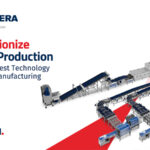Ever thought about how your favourite biscuits are made in large quantities and they all come out the same shape, same taste, and same crunch- every time? Behind the scenes, not only recipes or ingredients, but the state-of-the-art lines of biscuit manufacturing machines drive the mass production with unrivaled precision and efficiency.
These built-in systems comprise the pulse of contemporary biscuit production, from the combining of dough to its packaging. Biscuit manufacturing machines from trusted companies like New Era are intelligent, solid, and customizable to ensure that the producers can respond to ever-changing market needs without compromising on quality.
So, whether you just want to know more about how a Biscuit Production Line works or you are interested in finding out why the biscuit-making process is so important in the current competitive business environment, then you are at the right place, and we will take you through it all.
In this guide, let’s explore the entire process of biscuit manufacturing, how manufacturing lines work, and why they are important.
Understanding Biscuit Manufacturing Machine Lines
A biscuit manufacturing machine line is an automated, complex system that is used to process the entire production of biscuits on an industrial level. It contains a line of interfilled machines like dough mixers, laminators, sheeters, rotary moulders, tunnel ovens, oil sprayers, cooling conveyors, stackers, and packaging units. For example, the New Era Hard Dough Biscuit Production Line is designed to do all the processes of lamination through to final stacking of hard products such as Crackers and Cream Sandwiches with consistency and output at production scale.
These modules are designed to accomplish manufacturing tasks one by one with consistency, hygiene, and efficiency in mind. These lines limit manual handling, maximize the uptime of the production, and provide mass customization of the biscuit types. Biscuit manufacturing lines are essential for precisely controlled and modular flexibility to satisfy commercial demands on a large scale with a consistent quality of the product.
Why They Matter?
The capacity to make a large quantity of biscuits without sacrificing quality, safety, and variety is essential. This is where biscuit manufacturing machine lines come in to change everything. Automated systems are specifically designed to simplify all levels of the production process, including mixing, baking, packaging, etc. These lines are the backbone of efficient, scalable, and hygienic biscuit production. They enable manufacturers to achieve consistency in meeting the rising demand in the market at the lowest possible cost.
And here is why they are important:
Consistent Quality and Product Versatility
All the batches of biscuits will have similar texture, shape, and flavour due to automated and advanced-level biscuit-making machines. Also, these are able to produce a large variety of biscuits, plain, cream-filled, soft, or crunchy biscuits, with quick changeover.
High Throughput
All the batches of biscuits will have similar texture, shape, and flavour due to automated and advanced-level biscuit-making machines. Also, these are able to produce a large variety of biscuits, plain, cream-filled, soft, or crunchy biscuits, with quick changeover.
Lower Cost of Operation
The shaped dough is baked in high-capacity ovens at controlled temperatures to ensure uniform texture and flavor in every batch of biscuits.
Scalability
After baking, the biscuits are cooled gradually to prevent breakage and to ensure they are ready for packing or additional processes.
Export Readiness
The biscuits are packed using automated systems that ensure freshness and hygiene. Different packaging types are used based on product variants.
Step-by-Step: How Biscuit Manufacturing Machine Lines Work
Step:1
Dough Preparation
All the batches of biscuits will have similar texture, shape, and flavour due to automated and advanced-level biscuit-making machines. Also, these are able to produce a large variety of biscuits, plain, cream-filled, soft, or crunchy biscuits, with quick changeover.
Step:2
Laminating and Sheeting
The blended dough is then worked in laminators or sheeters according to the kind of biscuits. It is a stage that guarantees uniform thickness of the dough, important in crackers and layered biscuits. Sheeters and Laminators consist of multi-roll sheeters, reduction stations, and scrap return conveyors to facilitate zero-waste production..
Step:3
Forming and Cutting
All the batches of biscuits will have similar texture, shape, and flavour due to automated and advanced-level biscuit-making machines. Also, these are able to produce a large variety of biscuits, plain, cream-filled, soft, or crunchy biscuits, with quick changeover.
Step:4
Baking
Biscuits are placed in a tunnel oven after they are formed. The ovens must be modular and can support different kinds of fuels and baking zones to ensure perfect baking. The Hybrid Oven is a combination of direct gas-fired and convection, which is suited to those producers who seek flexibility in their baking environment with various products.
Step:5
Oil Spraying and Sprinkling
Biscuits receive a final treatment (post-treatment) by spraying with fine oil or by sprinkling with sugar/salt. This improves the texture, taste, and looks. The Oil Spray System offered by New Era is even in coating oil as a result of electrostatic sprayers and regulated nozzles. This saves oil wastage, and the end product has a superior gloss.
Step:6
Cooling
A cooling conveyor slowly lowers the temperature of biscuits to below the packaging dew point to avoid moisture retention. New Era Multi-Tier Cooling Conveyor (post-baking system) saves floor space and allows precision of airflow, vital to crispiness and efficient packaging.
Step:7
Stacking, Counting, and Packaging
Perfect biscuits are automatically packed and stacked into trays or pouches with synchronized systems that ensure there is no breakage. The Auto Stacker and Pack Feeder post-baking system by New Era offers intelligent stacking with actual time rejection devices of biscuits that are damaged or not straight.
The Future of Biscuit Manufacturing
Intelligent automation, sustainability, and versatility are factors that are creating the future of biscuit production. The number of manufacturers implementing Industry 4.0 technologies to streamline processes and cut down on wastages is on the rise. The global food processing market is expected to reach $299.7 billion by 2033, with a CAGR of 7.01%, citing demand for automation and digital tracking systems in food processing.
For the smart food production, the following advanced biscuit machines are needed:
- Intelligent Sensing & Machine Learning Detection
- Heat Recovery Eco-Friendly Designs
- Multifunctional Lines of Gluten-Free and Low-Sugar Products
Conclusion
The performance and the quality of your biscuit production strongly rely on the performance of your machine line. An investment in a best-in-the-world system is not just about speed of output, but consistency, compliance, innovation, and long-term scalability.
Decades of engineering experience and customer confidence allow New Era to present the rugged and flexible biscuit manufacturing machine lines, which bring the production potential to real success.


